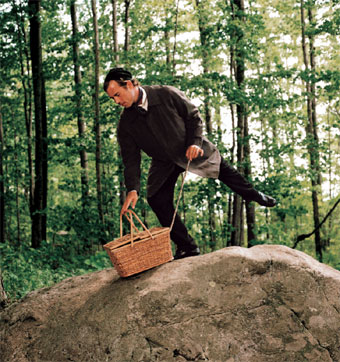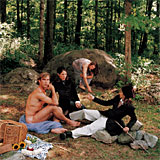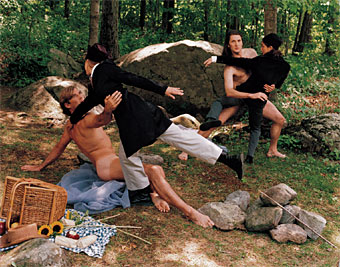
| 1.
Probable antecedents include works by Raphael (the now-lost
Judgment of Paris, replicated by Marcantonio Raimondi in an
extant engraving owned by the Boston Museum of Fine Arts); Michelangelo
(figure of Adam in the Sistine Chapel ceiling); and Manet’s
Pastoral Concert (owned by the Musée du Louvre), although
the attribution of that painting is currently in question. |
|
2.
Among the many dependent works are paintings of the same title
by Monet and Cézanne, and paintings by Courbet, Gauguin,
and Matisse. Picasso devoted a series of more than 200 works
in varying media to the Déjeuner. See “Making
Sense of Le Déjeuner sur l’herbe,” by Paul
Hayes Tucker, Manet’s Le Déjeuner sur L’herbe,
Cambridge University Press, 1998.
|
|
|
Manet’s
Le Déjeuner sur l’herbe is art history’s iconic
picnic: all of classicism leads up to it1; all of modernism leads
away.2 Shocking in its day — which was the mid-nineteenth
century — the Déjeuner has retained its provocative
character all through the years. From the outset, much has been
made about the lone nude figure in the scene. What seems to matter
is not so much that she is naked, but that no one else is. This
leads to a strange imbalance of power, but it is hard to say —
though art critics have made a lot of stabs at it 3 — exactly
how the scales are tipped. Here, in the grand tradition of reinterpretations,
choreographer Jamie Bishton, in league with photographer Tony Rinaldo,
stages his own recensions for 2wice. His is a double translation.
Manet worked in the studio, employing his favorite model, some visiting
relatives, and a painted backdrop. Bishton is outdoors, in the Berkshires.
Manet painted with pigment. Bishton paints with people. Yet Bishton
comes wonderfully and curiously close to the original. (Perhaps
this is because he is a dancer, with a dancer’s casual attitude
towards nudity, which is after all not unlike the attitude of a
studio model.)
In his most arresting staging, Bishton so marvelously approximates
Victorine Meurent, the naked luncher of the painting, that only
after your first apprehen-sion — that this is the Déjeuner
— do you realize that he has transposed the genders of the
Manet. The choreographer’s more faithful version, though factually
more exact — the women are women, the men are men —
is handsome and correct, but somehow more modest, less compelling.
Why? The exact copy, because it offers up the familiar, the iconic,
lacks the very frisson that made the Déjeuner so strange
and shocking in its day. The flipped version makes the familiar
new again. Bishton’s finale, the what-comes-after version,
shows what a lot of people think about when looking at Le Déjeuner
sur l’herbe. Namely, that something risqué or louche
is about to happen, or perhaps already has. But look again at the
naked Bishton and you will see what Manet saw, and know what Manet
knew.4 Under his clear-minded gaze, all things were equal. The naked,
the dressed, the tree,
the picnic basket, the cloth on the ground, the odd piece of fruit
— they are all the same to the artist, who brings all to the
same life, the same stillness. His was the most platonic of lunches
on the grass, a picnic for the sake of art.
|
 |
|
 |
| |
|
|
|
|
|
3.
See Bibliography, Tucker, op. cit.
4.
Barbara W.K. Cate, Director, Graduate Program in Musuem Studies,
Seton Hall University, pers. com.
|
|
|

dancers:
Jamie Bishton, Ashleigh Leite, Ana Gonzalez, and Andrew Robinson
|



